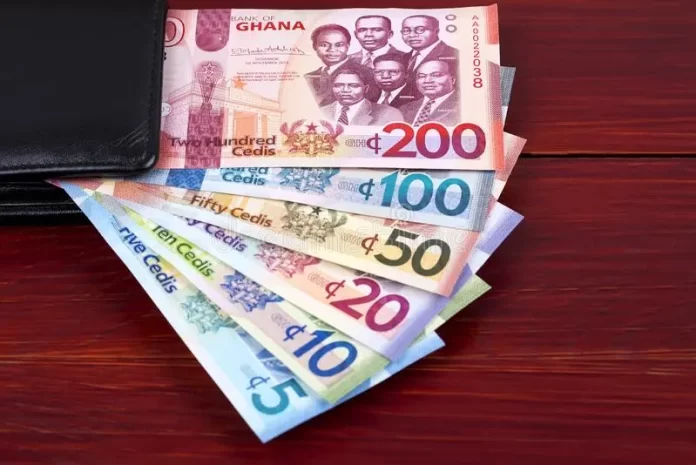By Ebenezer Chike Adjei NJOKU
The foreign exchange (FX) market is showing signs of stabilisation despite persistent gaps between official and retail exchange rates, with analysts attributing the divergence to structural supply constraints and recent regulatory interventions by the central bank.
As of Tuesday, June 17, the Bank of Ghana’s (BoG) official mid-rate for the US dollar stood at GH¢10.3 – down slightly from GH¢10.35 the previous day. However, parallel market surveys across Accra reveal retail buying rates ranging from GH¢12.1 to GH¢12.7 and selling rates clustering around GH¢13 per dollar, with some outlets quoting GH¢13.1.
This premium – between 17 and 23 percent above the official rate – points to pressures in the informal market, where physical cash remains in relatively short supply. Market participants and analysts say the mismatch is not driven by speculative panic but rather reflects tighter liquidity following new monetary regulations.
Courage Boti, Manager-Macroeconomic Research, GCB Bank, explained that the recent central bank directive requiring financial institutions to hold reserves in the original currency of foreign deposits has significantly reduced dollar liquidity in the system.
According to Mr. Boti: “Excess liquidity – up to 25 percent – has been mopped up into reserves at the Bank of Ghana because of that directive. That is accounting for the sharp decline in supply”.
The policy’s impact has been most visible in the retail cash market, which lacks the access to official sources of foreign exchange that banks and large corporates enjoy.
For consumers and small businesses in need of physical dollars – whether for travel, education or imports – the scarcity has led to a two-tiered pricing system: one for formal electronic transactions and another for cash purchases in the informal market.
Yet, despite the apparent divergence, Mr. Boti maintained that the exchange rate trajectory remains within expected bounds.
“We are not seeing the kind of daily volatility that would cause concern,” he said in an interview with B&FT.
“The rates have stabilised around GH¢12.6 to GH¢12.7 in the retail market, and this appears to be a correction toward the cedi’s true level,” he added.
He further stated that the current range is consistent with the president’s earlier indication of an acceptable exchange rate band of GH¢10 to GH¢12 and aligns with his own forecast of a year-end midpoint of GH¢12.70 – within a band of ±80 pesewas.
“That gives us a range of GH¢12.1 to GH¢13.5 and I am comfortable with where the market is trading now,” he said.
DataBank Research echoed this assessment in a note released on Monday, June 16 – stating that while the interbank market shows relative stability, pressures are more visible in retail segments.
The investment firm reported that the cedi depreciated 0.97 percent week-on-week in the interbank market, closing at GH¢10.35 per dollar. In contrast, the currency weakened 6.37 percent in retail markets to GH¢12.55 and recorded similar losses against the pound and euro.
According to DataBank, structural vulnerabilities – including seasonal foreign exchange demand and Bureau de Change (BDC) auctions – continue to undermine the effectiveness of central bank interventions. The firm also warned that global macroeconomic trends, particularly those tied to geopolitical instability, could weigh further on the cedi’s outlook.
“This week, we expect enhanced BoG interventions to anchor near-term stability amid potential gold windfalls from escalating Israel-Iran tensions,” DataBank noted.
“However, any stronger-than-anticipated safe-haven demand for the US$ relative to gold could drive further dollar gains against the local currency,” it added.
BoG has stepped up interventions in recent months, including forward FX auctions and gold-for-oil transactions as part of efforts to stabilise the cedi and improve price discovery in the foreign exchange market. Officials have also signalled an intent to strengthen regulatory oversight of the informal currency market, where price volatility tends to outpace broader economic fundamentals.
Nevertheless, analysts caution that unless retail dollar supply improves – either through higher remittance inflows, formalised BDC support or enhanced dollar liquidity programmes – the premium in the cash market is likely to persist.
For now, market observers describe the current environment as one of fragile equilibrium. “The divergence is real, but so is the stability. The cedi appears to be holding its ground within a range that reflects both policy intent and market correction. What’s critical is that we avoid large, sudden movements – and for now, we have not seen that,” Mr. Boti added.
He also said that as second-half of the year unfolds, both market sentiment and external dynamics will play a defining role in determining whether this relative calm endures or gives way to renewed volatility.










